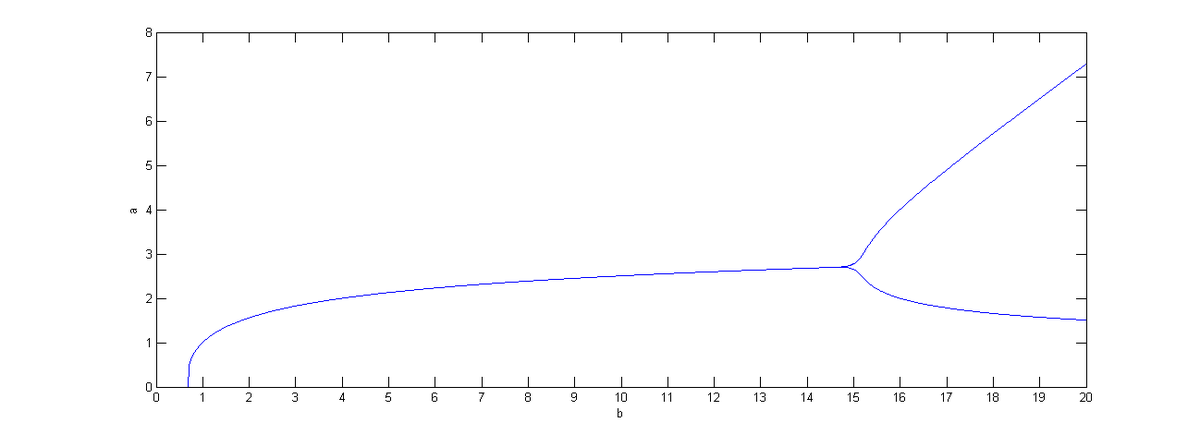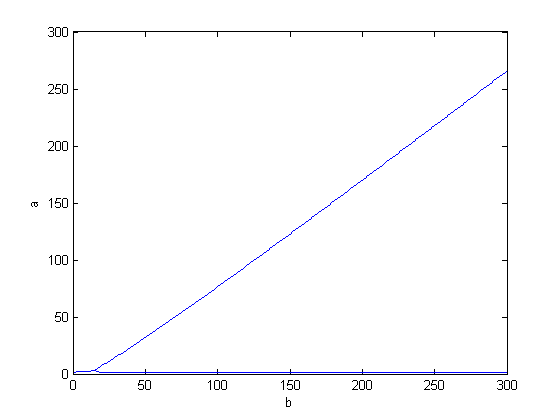Nested Fractional Exponent Discovered
The sequence ( − 1 ) , ( − 1 ) ( − 1 ) 1 , ( − 1 ) ( − 1 ) ( − 1 ) 1 1 , … clearly converges to the integer − 1 .
The sequence ( 4 ) , ( 4 ) ( 4 ) 1 , ( 4 ) ( 4 ) ( 4 ) 1 1 , … converges to the integer 2. (Can you prove it?)
Does there exist another value b = 1 , − 1 , 4 such that the sequence { a n } defined recursively by a 0 = b ; a n + 1 = b a n 1 also converges to an integer?
Note: Written out, this sequence is ( b ) , ( b ) ( b ) 1 , ( b ) ( b ) ( b ) 1 1 , … .
This section requires Javascript.
You are seeing this because something didn't load right. We suggest you, (a) try
refreshing the page, (b) enabling javascript if it is disabled on your browser and,
finally, (c)
loading the
non-javascript version of this page
. We're sorry about the hassle.
6 solutions
Can you tell me was it an intuition or proper mathematical way of choosing b=0.5??Can you find another number or give a range of numbers(set)??? @Mark Hennings @Chew-Seong Cheong
Log in to reply
If you look at the report I made about the earlier version of the question (when b was fixed at an integer), you will see that I (essentially) found that values of b ≥ 3 and b < 0 are impossible. Once the question was made precise, there was only a limited area in which to hunt. Certainly b = n 1 for any integer n ≥ 2 will work.
Is it really appropriate to say that when b is equal to 1/2 then it converges to zero? when the next term after that is undefined?. Unlike the prior examples 1, -1 and 4... this case doesn't reiterate afterwards.
Log in to reply
If b = 1 / 2 then a n is defined for all n , and converges to 0 , as I have shown. What you mean be "this case does not reiterate afterwards" is totally unclear to me.
Heya Ivan. I think you're worried about the division by zero that occurs "after" the sequence gets to zero. The beauty of converging sequences is that they don't necessarily actually ever reach the number they're converging to. They just get closer and closer and closer and closer; a closeness that can be precisely and mathematically defined. But the point is that none of the terms in the sequence are actually equal to zero, so there's never any division by zero.
The original question is basically to prove that the sequence a 0 = b ; a n + 1 = b a n 1 converges to 2 when b = 4. From basic definition of the convergence of a sequence, we know that if a n converges, then n − > ∞ lim a n = n − > ∞ lim a n + 1 = L So, as n − > ∞ , it follows that the sequence formula becomes L = b 1 / L . Hence, raising both sides to power L gives the expression L L = b .
Hence, for b = 4 , the sequence will converge to a value L , provided L L = 4 , from which it easily follows that L = 2
Based on the above, I would conjecture that the above sequence would converge if b = 27 ( = 3 3 ), or any other "self powered" value.
Moderator note:
This argument contains a very common misconception that is often made. (Can you spot it before reading ahead?)
It makes the assumption that the limit exists, and then justifies that L = 2 , to claim that the limit exists. This is a circular argument. In fact, the limit might not exist, as shown by Jose for large enough (b)). In particular, for b = 2 7 it does not converge (much less to an integer).
So, care has to be taken to show that for b = 4 , the limit is indeed L = 2 .
Looks like 'self powers' would be the rightful candidates for b so that the sequence converges. But it looks like a tall order to characterise such numbers, considering that b=1/2 also yields a convergent sequence.
If you look at my report for this problem (which originally asked for integer b values), you can see that that the case b ≥ 2 7 (or if you like L ≥ 3 ) does not work, since the sequence a n is then oscillatory, and not convergent.
Thanks, all!! I stand corrected! :)
I'll try to prove it.
Let us assume that the sequence does coverge, to the value a ∞ . Thus, a ∞ = a ∞ + 1 = b a ∞ 1 , which means that a ∞ a ∞ = b (Sorry for the abuse of notation). Notice that for every b > 1 , a ∞ > 1 this is a bijection, and a ∞ < b thus we can find some a ∞ that satisfies that condition.
Now lets prove that it must converge, that is to show that L i m n → ∞ ∣ a ∞ − a n ∣ = 0 , for Can it be done?
It can be shown using induction on n that a 2 n > a 2 n + 1 , a 2 n + 2 < a 2 n , a 2 n + 1 > a 2 n − 1 .
The sequences a 2 n + 1 and a 2 n must converge to some values between a 0 and a 1 , or otherwise at least one of the inequalities above will not hold.
WLOG assume that L i m n → ∞ a 2 n = C , b b 1 = a 1 < C < a 0 = b . It must hold that C = b b C 1 1 = b − b − C 1 , thus C b C 1 = b .
To solve it, assume b = C d for some 1 < d < b , i.e. d = l o g C ( b ) . It gives in the previous equation C b C 1 = C d , thus b C 1 = C C d = d that is C C 1 = d d 1 . This is very tricky, as when C and d are both bigger than 1 there are two solutions: C = d but also another non analytic solution where 1 < C < e → d > C and C > e → 1 < d < C . Thus b = C C or b = C d = d C .
For the sequence a 2 n + 1 we get the similar results - if L i m n → ∞ a 2 n = K than b = K K or b = K p = p K ( d ′ = l o g K ( b ) ) .
If b = C C than C = a ∞ because it is a bijection, and the same goes for b = K K . In that case, the sequence converges, and we're done.
At all the other cases, we have the equation K p = p K = C d = d C , and also we know K ≤ C , thus d ≤ p .
I admit, I'm kinda stuck here :( . If anyone has an idea how to show that these other solutions are inconsistent, write it in the comments.
I approached it numerically for positive values of
b
, I haven't done any math on it (sorry about that) yet I found something funny happening, the series seems to converge to zero for values of
b
<
B
1
≈
0
.
6
, then for values
B
1
<
b
<
B
2
≈
1
5
it converges to a positive number
a
(including
a
=
2
when
b
=
4
) and then after
B
2
it stays oscillating in a cycle between two numbers. Here is what I mean in a picture, for each value of
b
I'm plotting
a
n
for
n
=
9
9
0
,
9
9
1
,
…
,
1
0
0
0
:
 This really reminds me of the behavior of the logistic map, so I plotted for bigger values of
b
hopping to find something, but the arms just continued without bifurcation apparently in a straight line, here is a picture:
This really reminds me of the behavior of the logistic map, so I plotted for bigger values of
b
hopping to find something, but the arms just continued without bifurcation apparently in a straight line, here is a picture:

The ~0.6 value you encountered is most likely the minimum of x^x.
Log in to reply
Very good observation. The min value is e 1 e 1 ≈ 0 . 6 9 2 .
Can you explain for smaller values of
b
, why
1. if the limit exists, then it must be 0.
2. the limit exists.
So what I did is i rewrote the sequence as a n = b b − b − b . . . − 1 ( n + 1 copies of b )
Now i substituted c = − b and took l o g − c twice: l o g − c ( l o g − c ( a n ) ) = c c c c . . . − 1 ( n − 1 copies of c ) In order for a n to converge to a number, the right term must also converge to a number. Now I got stuck here but I'm pretty sure that converges for every c < 0 or b > 0 ...
It is clearly a strictly decreasing sequence with terms greater than 1 this as it grows smaller and smaller where would it go
If we put b = 2 1 , then we have a 0 = 2 1 a 1 = ( 2 1 ) 2 = 4 1 a 2 = ( 2 1 ) 4 = 1 6 1 and, in general a n + 1 − 1 = 2 a n − 1 so that the a n − 1 form a tetration tower, a n − 1 = 2 2 2 ⋅ ⋅ ⋅ 2 ( n + 1 copies of 2 ) which diverge to ∞ , and hence a n → 0 as n → ∞ , and (of course), 0 is an integer.